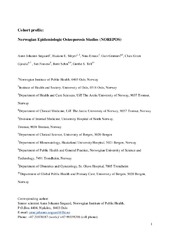Cohort profile: Norwegian Epidemiologic Osteoporosis Studies (NOREPOS)
Permanent lenke
https://hdl.handle.net/10037/6803Åpne
This is the accepted manuscript version of the article. Published version is available at Scand Journal of Public Health, December 2014 vol. 42 no. 8 804-813 (PDF)
Dato
2014-10-02Type
Journal articleTidsskriftartikkel
Peer reviewed
Forfatter
Søgaard, Anne Johanne; Meyer, Haakon E; Emaus, Nina; Grimnes, Guri; Gjesdal, Clara Gram; Forsmo, Siri; Schei, Berit; Tell, Grethe SeppolaSammendrag
Aims: This paper describes the history, purpose, data collection and contributions in the research collaboration Norwegian
Osteoporosis Epidemiologic Studies (NOREPOS).
Methods: NOREPOS encompasses almost 85,000 bone mineral density measurements within Cohort of Norway and data on almost 140,000 hip fractures in Norway 1994–2008. Included are anthropometric measurements, blood pressure, lipids and glucose, and 50 standard questions on sociodemographic factors, diseases and risk factors. Blood samples/DNA are stored. The main research question posed in NOREPOS is why hip fracture rates in Norway are the highest in the world. Data on hip fractures 2009–2013 will be added in 2014.
Results: Main findings include: Every hour a Norwegian suffers a hip fracture; hip fracture incidence rates declined after 1999; only 16% of patients used anti-osteoporosis drugs 1 year after hip fracture; 25% of patients died within 1 year after the fracture; 12% suffered a new hip fracture within 10 years; rural dwellers had lower hip and forearm fracture incidence than city dwellers; magnesium in tap water may be protective whereas bacterial contamination, cadmium and lead may be harmful to bone health; low serum vitamin D and E levels were associated with higher hip fracture risk; vitamin A was not associated with fracture risk; and abdominal obesity increased the risk of hip fracture when BMI was accounted for.
Conclusions: NOREPOS encompasses a unique source of information for aetiological research, genetic studies as well as for biomarkers of osteoporosis and fractures. Because of the increasing number of elderly people in Europe, hip fractures will continue to pose an international public health and health care challenge.
Methods: NOREPOS encompasses almost 85,000 bone mineral density measurements within Cohort of Norway and data on almost 140,000 hip fractures in Norway 1994–2008. Included are anthropometric measurements, blood pressure, lipids and glucose, and 50 standard questions on sociodemographic factors, diseases and risk factors. Blood samples/DNA are stored. The main research question posed in NOREPOS is why hip fracture rates in Norway are the highest in the world. Data on hip fractures 2009–2013 will be added in 2014.
Results: Main findings include: Every hour a Norwegian suffers a hip fracture; hip fracture incidence rates declined after 1999; only 16% of patients used anti-osteoporosis drugs 1 year after hip fracture; 25% of patients died within 1 year after the fracture; 12% suffered a new hip fracture within 10 years; rural dwellers had lower hip and forearm fracture incidence than city dwellers; magnesium in tap water may be protective whereas bacterial contamination, cadmium and lead may be harmful to bone health; low serum vitamin D and E levels were associated with higher hip fracture risk; vitamin A was not associated with fracture risk; and abdominal obesity increased the risk of hip fracture when BMI was accounted for.
Conclusions: NOREPOS encompasses a unique source of information for aetiological research, genetic studies as well as for biomarkers of osteoporosis and fractures. Because of the increasing number of elderly people in Europe, hip fractures will continue to pose an international public health and health care challenge.
Forlag
SageSitering
Scandinavian Journal of Public Health (2014), (online first)Metadata
Vis full innførselFølgende lisensfil er knyttet til denne innførselen:


 English
English norsk
norsk